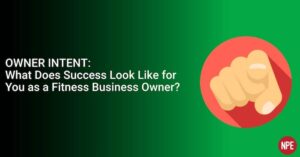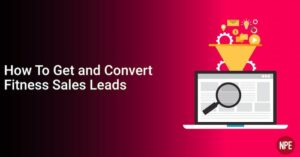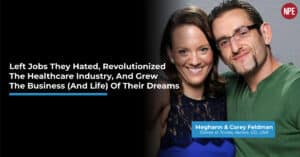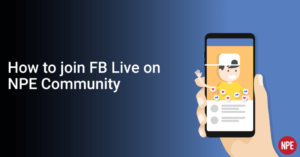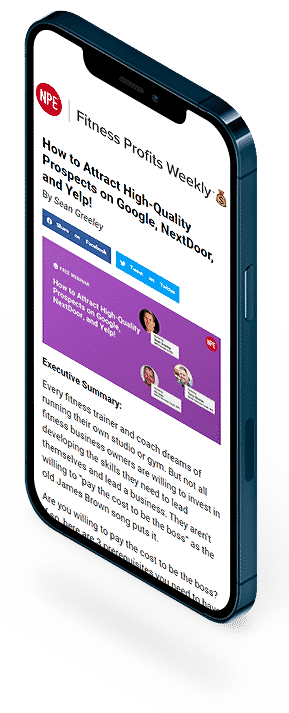How to Overcome “I’m Not Interested in Online Training” Objections: Moving Offline to Online, Part 2
By Sean Greeley
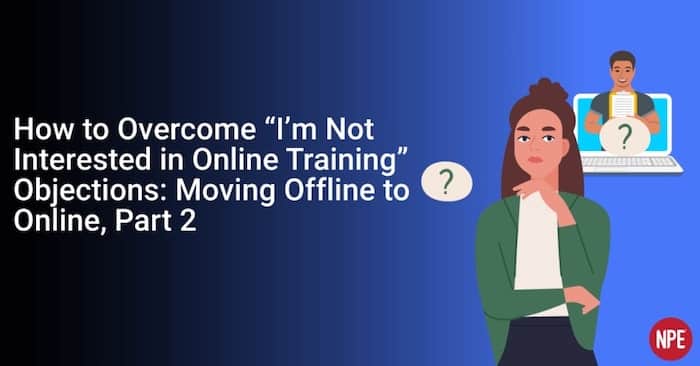
Executive Summary:
If you’re like most fitness professionals and studio owners, you are hearing the same objections over and over again like “I’m not interested in online training” or “I’ll just wait until the studio opens back up again” when you try to engage your existing and new clients to sign up for online training. In this article, we’ll cover how to overcome those objections and how to lead conversations more effectively so clients will engage, see the value, and begin to make progress again with their health and fitness program.
++++++++++++++++++++++
Your studio or gym is closed.
Active clients have left (and continue to drop off).
You reach out to try to engage them and ask, “Are you interested in online training?”
They say no.
Or they don’t say anything at all … you just hear crickets.
Or perhaps you’ve been able to connect with them by phone … only to hear objections such as:
- “Yeah, I’ll just wait until we’re back in the facility to start training again.”
- “I’m just going to follow along with some at-home workouts right now and will get back to you once COVID-19 is over.”
- Or something along those lines … but the bottom line is they aren’t engaged.
And you are pulling your hair out!
Your business needs clients training to generate revenue (and pay your bills).
And just as important… you know your clients that aren’t training are sitting at home, losing strength, gaining weight … maybe their pain is returning … and backsliding on all the progress they’ve made with their health and fitness in working with you.
Not only that… but the stakes are high.
They’re dealing with all new kinds of challenges–working from home, kids home from school, maybe a job loss, and other disruptions to their lives–looking after themselves when it comes to fitness, nutrition, recovery, stress management, and more is critical!
So what do you do?
Here’s the basic overview:
- Identify the problem where it REALLY is–It’s a sales problem. It’s not a marketing problem. You don’t need more ads and email addresses. You need to learn how to inspire hearts and minds and more powerfully lead “commitment” conversations.
- Recognize you’ve got to meet them where they are right now. Clients are aware there’s a PROBLEM. And they’re aware of the SOLUTION in working with a fitness coach. But they don’t yet understand the PRODUCT. They don’t know what online training is or how it works. You need to educate them on what it is (coaching) and what it isn’t (watching you tube videos of workouts).
- You need a sales strategy and offer. You need to have a strategy for reaching out to them and have an offer ready. Right now, the best offer to use is FREE trial or FREE session. Let them experience what online training IS and how it works. Then you need to be able to deliver WOW. Demonstrate to them how the coaching you provide will be the difference maker in achieving their goals.
- You need better communication skills. That starts with having a system to lead commitment. That’s executing the AUTO-CLOSER® 7.5 step communication system.
- You need a process to overcome objections. Too many fitness professionals and studio owners feel guilty about challenging those objections. So they let people off the hook, instead of guiding them to commit to their health and fitness goals.
- You need to get organized, make a list, and get work reaching back out to everyone! It’s easy to drop into a haze of random actions yourself. Stop, get yourself organized, get your messaging and offer right, and you can get to work reaching out with good strategy in place!
Once you’ve got the communication skills to lead hearts and minds (and systems in place to close sales), then most urgent is that you re-engage with your most recently active clients. They need you now more than ever… even if they don’t realize that just yet!
Here’s what I mean by that: Even if you got a NO in the first week or 2 from COVID-19, the reality is that after the “holiday fun” wears off … people want to re-engage.
Watching Netflix and ordering Uber eats like it’s Christmas maybe fun for a little while… but pretty soon no one is feeling good about their current habits and results around their health and fitness.
Keep engaging, keep reaching out, and don’t give up on them! They need you now more than ever to believe in them … especially when they don’t yet believe in themselves!
Let’s break these steps down in a little more detail…
Step 1: It’s a Sales Problem
People think they need some marketing hack to figure this out. What ad should I run to grow my business right now?
No, this is a sales issue. You need to learn to sell (better).
What does that mean?
That means you need to learn how to LEAD people’s hearts and minds to commit to their OWN goals.
That means engaging powerful conversations about your clients’ and prospects’ goals and challenges, and leading them to make a stronger commitment than ever before to the journey required in BECOMING the person they want to be.
And that’s the difference between a trainer and a coach. (See Part 1 here.) Trainers do programming and technique.
Coaches challenge us to become the best version of ourselves. You need to be a better coach than you’ve ever been.
Trainers (and cheerleaders) are a dime a dozen.
Coaches help others grow through this challenge.
You need to know what to encourage them, and when to give them a kick in the pants. Your clients will need all of that at different times.
Step 2: Meet Them Where They Are
What are their new circumstances? Where are they at right now? How are they facing the challenges of isolation, stress, and backsliding?
How is their health and fitness? How is their mental health and well-being?
They probably know they need to work out. But they’re struggling with how to do it … when they don’t have the equipment, when they’re not in an environment like their gym.
When they don’t have a good program, and their schedule is overhauled …
For example, we’ve heard people say: OK, we’re home with kids. These days of the week, I’ll work out and you give the kids breakfast. Those days of the week, I’ll give the kids breakfast and you work out.
You have to help people create a success plan and new habits that support them in a different environment.
They’re aware they are gaining weight, are stressed out, and feel terrible.
They know they need to work out and to eat better. But they don’t understand the value of working a coach remotely to do so. COACHING is not watching youtube videos or instagram workouts. I’m not going to send you a templated workout and hope it works out. As a coach… you’re doing to do a LOT Of things that help someone in getting to where they want to be from assessment, program design, teaching technique, providing accountability and support, education around nutrition/recovery, and community. Your job is to help them understand how each of these components work to provide value (and lead them to success!) with online coaching.
For example: “We understand. And here’s what we can do for you online. Here’s how it works … We’ll assess where you are right now, what your biggest stressors are … where are your biggest opportunities … what equipment and space do you have access to … and we’re going to put the right plan together for you to get on track and meet your goals … I’m going to show you how to execute the program, whether I send the program to you and hold you accountable, or whether we get on a Zoom call and I coach you directly … keep you connected and engaged.”
Step 3: You Need a New Sales Strategy and Offer
There are normally lots of different types of offers out there that we recommend … low barrier offers, short term trials, paid assessments, and the like.
But this isn’t “normally”.
Right now, nobody is buying anything until they know what it is and what value it provides.
Your best bet right now is to go FREE.
For example, free sample sessions for private and free trial sessions for groups.
Here’s the key:
Yes, you have offers from your “core menu” of programs. But right now, you also need to have a downsell option.
Shorter-term for private, such as a two-month offering.
And for groups, a 4-week or 6-week challenge.
If you have an objection to committing to a longer term program (like 3, 6, or 12 months) then don’t discount… instead offer a shorter term engagement. Some people are just unsure how things will play out … lots of uncertainty, and they are not willing to make long commitments into the future. And that’s ok.
With a shorter term 4-weeks to 8-week offering, usually they can commit to that to get them through this and then you can resign them at that time to a longer term commitment.
(And MOST importantly… you get to keep delivering WOW. See Part 1.)
Step 4: Upgrade Communication Skills
Use our 7½ step sales system called AUTO-CLOSER®.
This system consistently inspires clients to commit to their health and fitness goals–and your programs. You want to:
Step 0.5: Pre-qualification. Most sales consultations fail because of 3 known objections. Stalls (“I want to think about it), Decisions (“I need to check with my spouse”), and Price (“I can’t afford that.”) And you discover all three at the end of your presentation. Not good.
That’s why you PRE-QUALIFY everyone on the phone before you invite them in for a sales consultation. You tell a range of your prices and ask if they have the budget for that, ask if anyone else needs to be in on the decision (and if so, invite them), and explain that at the end of the consultation if you’re a good fit to work together you’ll be asking them to make a decision to move forward yes or no. Only when you have the right answers to these questions do you schedule a consult. This will save you lots of time.
Step 1: Build rapport. People buy from people they know, like, and trust. Find common ground, smile, and get them talking.
Step 2: Probe and discover. As they are talking, ask open-ended questions. “Tell me about your health and fitness goals …” “Why are those goals important to you?” “How committed are you to achieving your goals on a scale of 1-10?” (Don’t go forward without a 10.)
Step 3: Identify needs. Clearly see the need – you must know your clients better than they know themselves.
Step 4: Build the problem. Bring clients’ needs to the surface … help them understand they have a problem and how it impacts their life … creates limits on their relationships and their daily activities and what they can do. This is the most critical step.
Step 5. Present the solution. Show how your product or service will solve their problem. Use a visual presentation (with pictures, charts, and graphs–they are much more convincing). Have social proof and stories, risk reversal (a guarantee), make prospects feel important, and reassure them.
Step 6: Close the sale. Offer an opportunity to solve the problem. Give them two choices, a longer program and a shorter one, and ask: “Which would you prefer?”
Step 7: Objection handling. Follow this process: (1) Listen and never interrupt (2) Repeat the objection (3) Answer it (4) Confirm the answer to remove the objection. Then (5) ask for the sale again.
If you are doing this system correctly, you should be overcoming objections before you get to the “close the sale” section.
But let’s take a deeper look at objection-handling.
Step 5: Use a process for objections
The basic strategy is “free trial” and then you come in and deliver WOW. If you can’t deliver WOW, you can’t sell.
But if you CAN deliver WOW, selling becomes easy.
Still, some people will offer objections.
Let’s break down the process in more detail.
- Listen and don’t interrupt. There’s a thought process people go through when they are coming up with objections. You don’t want to interfere with that process … or interrupt them. That’s because they want to finish the process first. Let them finish and never interrupt.
Example: “I’m not sure I want to work out online. I’ll just come back after this is over.”
2. Question the objection. Ask an open-ended question because that doesn’t let them answer ‘yes’ or ‘no,’ but requires them to form a thought, opinion, or idea. That changes the conversation. Sometimes, just questioning it removes it.
Example: “I completely understand this is something new you haven’t tried before and maybe skeptical about. But let me ask, what is it you’re not sure about exactly when it comes to working with a coach remotely?”
3. Challenge the objection. Introduce a competing idea or thought that helps them see it from a different perspective.
For example: “If you could have a plan with the equipment you have and arrange your schedule differently, had someone supporting you and holding you accountable to getting the workout done… what makes you think you won’t be able to get the results you want?”
4. Remove the objection. Ok I see what you’re saying. A coach will be the difference maker.
Example: “Yes. Having someone to guide you, support you, and hold you accountable is the difference between top performers and everyone else in every area of life.”
5. Ask for the sale again. Go back to the close.
As you do this, write down the objections. Come up with a list of them. Start to practice how to challenge these objections. Role play. Practice with a friend or colleague.
Don’t just give up when someone objects, but be ready with how to address it effectively and put prospects’ minds’ at ease.
Step 6: Get organized
Create a list or spreadsheet. Include:
- List of contacts.
- Contact details.
Start using the process and tracking your results as people re-engage.
Make your list, and don’t stop until you connect with everybody.
Let people know you’re thinking about them. Ask them how they and their family are holding up?
What’s happening with their fitness right now? What new challenges are getting in their way? How are they handling them?
Then invite them to take advantage of your FREE trial or session.
Whatever objections you’re getting, write them down. Go back and brainstorm ways to better address objections. It will show you where you need to improve … questioning and challenging objections and getting people to commit to their goals.
Finally, time is actually ON YOUR SIDE.
People may say “no” at first, but …
When they’re sitting on the sofa watching movies and eating take out, and then that gets old fast.
Everyone who was working out feels terrible. They’re gaining weight. Their energy levels are crashing. Their motivation, morale, and enthusiasm are nose-diving.
They KNOW they need to get back to their fitness routine, but they don’t see how they’re going to be able to get it done.
And that’s why YOU showing up to engage them is so important. They need you to believe in them… even when they don’t yet believe in themselves.
Once they DO engage, you deliver WOW … and they see the value. Then they sign up for your programs to remain connected and engaged.
Summary
People need you now more than ever. Lack of engagement simply means they have not been inspired to the level required to commit to their goals … and that’s a sales (and leadership/coaching) problem. Fix it by meeting them right where they are RIGHT NOW.
Approach with a free trial offer to get them engaged. You have to be able to deliver WOW. Strengthen your sales process using AUTO-CLOSER® and have a process in place to overcome predictable objections.
And get organized, make a list, and start reaching out. Coaches step up; trainers wait for handouts. Be a coach and start leading your clients (and prospective clients) BACK to your fitness business, so they can stop backsliding and start progressing.


